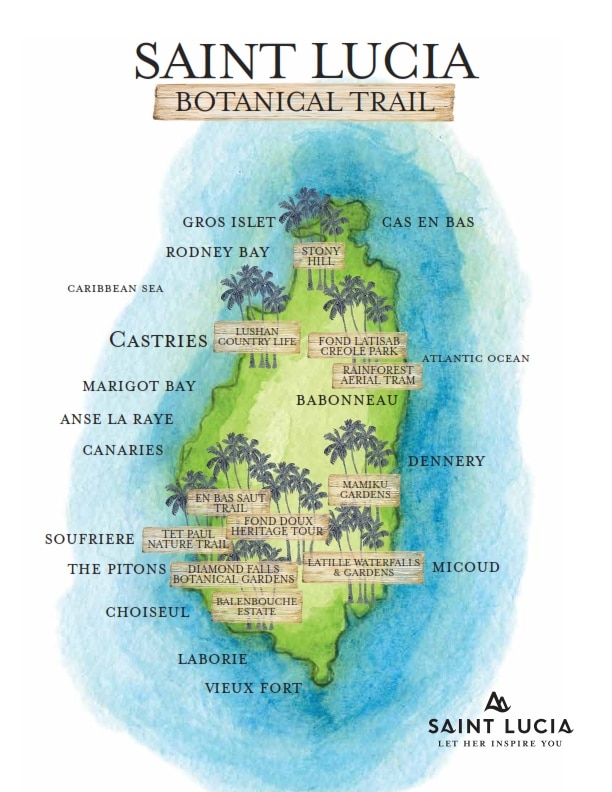Let Her Inspire You
Health & Wellness
Let Her Inspire You
Botanical Trail
Discover the many plants in Saint Lucia that have been part of traditional Caribbean healthcare for generations, and are now being accepted and incorporated into modern medicine.
With over 1,300 different species of wild flowering plants and 150 species of ferns squeezed into less than 620 square kilometres, Saint Lucia is a botanical paradise.
Follow our Botanical Trail which takes you to attractive gardens and parks across Saint Lucia, where guides can show you some of the most important plants for natural health remedies and medicines.
To get your green fingers going, here is a list highlighting some of the most popular plants you’ll find on the island.
They include:
1. Cymbopogon citratus (lemongrass)
What it does: Anti-oxidant and immune boosting, it is thought to be effective against: dandruff, stomach cramps, fever, common cold, exhaustion, anxiety, insomnia, headaches, and can also be used as an antiseptic, astringent and mosquito repellent.
2. Lippia Alba (Santa Maria)
What it does: Thought to be stress-busting, effective against colds, fevers, indigestion, bowel complaints, and yeast infections in any part of the body.
3. Justicia pectoralis (carpenter’s grass)
What it does: A relaxing tonic, it is considered helpful for the management of endometriosis, menopausal symptoms, PMT, and menstrual pains due to its strong estrogenic, progestogenic, and anti-inflammatory properties. Also used for fever, cough, colds, sinus problems and to aid circulation.
4. Justicia secunda (St John’s Bush)
What it does: Used for centuries to help women, it is thought to stimulate the womb, fallopian tubes and ovaries, assist with the proper functioning of the reproductive organs and aid menstrual cramps. Excellent to prepare for pregnancy, but should not be taken during pregnancy.
5. Momordica charantia (bitter melon)
What it does: Detoxifies by causing the liver to work more efficiently, thought to help improve skin conditions, help control diabetes and normalise blood pressure, and has strong anti-oxidant properties.
6. Morinda citrifolia (noni fruit)
What it does: Thought to boost the immune system, energise the body, normalise blood sugar in diabetics, and enhance prostate health. Also has pain relief properties, and can decrease swellings.
7. Moringa oleifera (tree of life)
What it does: Considered one of the most nutrient rich plants on the planet, gram for gram moringa leaves contain 7x the vitamin C in oranges, 4 x the calcium in milk, 4 x the vitamin A in carrots, 2 x the protein in milk and 3 x the potassium in bananas.
It is believed to improve the immune system, promote energy, beautify the skin, promote the functioning of the liver and kidneys, assist digestion, be an anti-inflammatory, help reduce cholesterol and normalise blood pressure, regulate the thyroid, help prevent dementia, and have antibacterial, antifungal and antioxidant properties.

8. Ocimum basilicum (basil)
What it does: With anti-inflammatory and anti-oxidant properties, it is considered effective against inflammatory bowel diseases, is antibacterial and reduces the effects of oxidative stress as well as helping the body adapt to stress.
9. Petiveria alliacea (horney goat weed)
What it does: A traditional remedy to treat cancer, modern research has shown extracts can indeed assist in cancer treatment. It is thought to stimulate the immune system, lower blood sugar in diabetes, help with arthritic pain and rheumatism, bring on menstruation, help remove mucus and phlegm from the body and help fight infections.
10. Pimenta racemose (bay leaf)
What it does: Believed to act as a pain relief, soothe the stomach (assisting with IBS, coeliac disease and diarrhoea), fight migraines, protect against cardiovascular diseases, lower cholesterol, strengthen the immune system, have a sedative effect, promote hair health, alleviate respiratory conditions, and work as an effective remedy for sore throats, coughs and colds.
